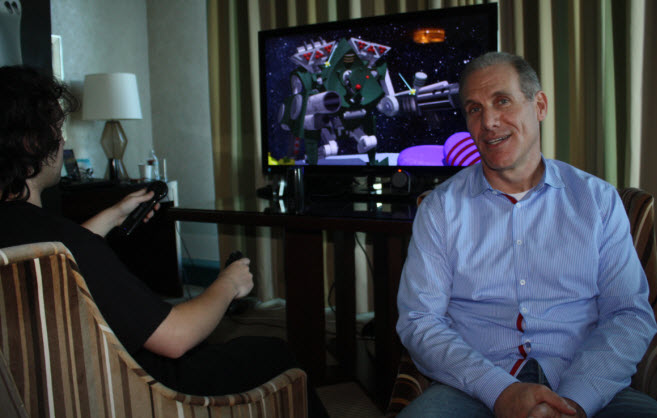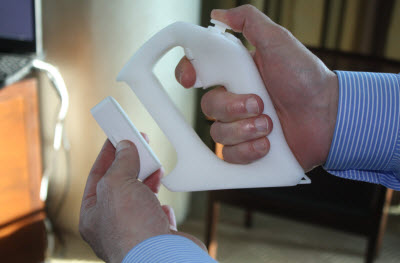Sixense Entertainment is launching a Kickstarter crowdfunding campaign on Thursday to raise money for a wireless version of its motion-sensing game controllers. The startup hopes to seize the day by piggybacking on the rebounding popularity of virtual reality gaming.
The Sixense technology, which is based on motion-sensing magnets that give you 360 degrees of freedom to control objects in a 3D space, has been in the market for sometime via licenses with Razer, which makes the Hydra PC gaming controllers, and Valve for its Portal 2 In Motion game. But the 3D-sensing controller has gotten a new life with the popularity of the Oculus VR virtual reality goggles. After all, if you’re going to explore virtual reality, you need more than a headset. You need a new user interface to help you naturally interact in a three-dimensional space. And that’s giving Sixense a chance to redefine itself and launch a new strategy that includes selling its own branded merchandise.
Amir Rubin, chief executive of Los Gatos, Calif.-based Sixense, said in an exclusive interview with GamesBeat that Sixense’s motion-sensing technology is a great fit for the Oculus Rift. Ever since Oculus VR launched its developer version of Oculus VR, the Razer Hydras have been selling out.
“They cleaned Razer out,” Rubin said. “The community wants more units. And they also don’t want wires. When your eyes are covered, you want a wireless experience.”
But the Hydras are wired controllers, and if you use them with virtual reality goggles, you can quickly find yourself all tangled up. So Rubin is launching a Kickstarter campaign to raise $250,000 for a wireless version of its motion controls.
On top of that, Sixense is creating its own branded product, the STEM System, for the wireless 3D controls. The STEM System consists of a base that contains a magnet that sends out pulses into a 3D space. The magnetic waves hit sensors and then bounce back to the base. The system calculates how long it took for the interaction and then figures out exactly where the object is in a 3D space. It works whether you have a line of sight or not, which makes it different from Microsoft’s Kinect motion-sensing system in that regard. The STEM System is also modular; you can put the motion sensors in a variety of places and positions.
“Until now, we were a technology company that enabled brands like Razer, Valve, and Namco Bandai to create technology,” said Rubin. “This is an opportunity for us to launch our brand as a consumer product. We believe it is a good gamble to become a product company rather than a technology provider.”
Hardware makers will still be able to license designs from Sixense so they can embed it in their own products, as Sixense will support an open hardware and software development environment. Rubin encourages the community to create a wide variety of motion-sensing devices, such as swords, baseball bats, or head-mounted displays. The system works with Linux, Windows, and Mac.
“We do not stand in the way of any applications,” Rubin said. “Any developer can take the SDK and develop with it.”
The licensees can integrate the STEM technology into their products to make them Sixense compatible. Rubin foresees the STEM technology as the best way to navigate through a virtual reality world. The new system will have longer range of eight feet, wireless operation, modularity, and better tracking performance at all ranges. It also will be backward compatible with the library of games that support the Razer Hydra. And it supports up to five devices.
The wireless controller sensors can be placed on any part of your body to detect your motion. Rubin founded the company in 2007, but he has been working on motion-sensing technology for about two decades. Sixense has 18 employees and it has raised $3 million to date.
Brendan Iribe, the chief executive of Oculus VR, said, “We love to see other companies working on solutions for tough problems in the virtual reality space. Sixense is doing great work in the motion tracking arena with their Hydra and new STEM technology. We’re always looking forward to seeing how others approach the problems and enjoy playing with the various solutions. The community has had a lot fun experimenting with Hydra. Everyone’s learning a ton, including us. It’s still just the beginning, day zero. The future of wearable computing and virtual reality is being created now. I really believe this is the most exciting time to be in gaming, digital entertainment, even mobile technology.”
The Sixense system also works with the Virtuix Omni Treadmill, another virtual reality system that has a walking and fitness angle. Sci-fi author Neal Stephenson, who wrote Snow Crash, is also a supporter. He says the STEM System could be part of a great swordfighting game based on the Clang game created by his startup, Subutai.
Sixense has created its own game studio in San Francisco to create demos that make use of its technology.
In the meantime, Sixense is showing off motion-sensing game demos created by others. I played a couple of demos that combined the STEM wireless controller prototype with the Oculus Rift.
The first-person shooter demo, Crashland, was created by an outside developer, Llyr ap Cenydd. In the demo, you can maneuver using two STEM controllers in both hands. In the demo, you have a gun in each hand. You can turn around and point them at giant spiders that attack you from all directions. You pull the triggers to fire the guns, and use pointing sticks to control your aim. You move your head to spin your body in different directions.
I was able to pick up the game demo and shoot the spiders with relative ease. The virtual reality didn’t make me nauseous, either. The aiming was accurate, and the experience replicated what I could do on a PC or console in a first-person shooter. I fired by pulling a trigger with my finger, and I pulled up a radar with my left hand so that I could see where the spiders were coming from. I reloaded by pressing a button. I could see how a real game based on the STEM could be fun. And I could also see how fast I could control the experience, without getting really sick.
The second demo was a spooky 3D world called The Gallery: Six Elements, from Cloudhead Games in Vancouver. Using the hand controls and the headset, I waded into a dark sewer. Rats scurried past me as I sank lower into the water. I looked around, and the Oculus VR headset tracked well. Then I came to a ladder and used my hands on the Sixense controllers to climb the ladder. I put one hand in front of me, squeezed the trigger, and the virtual hand grabbed a rung on the ladder. Then I pulled my arm down and it simulated a climbing sensation. I let go of my grip and then reached up to grab the next rung. It was tricky at first, but it worked.
Another demo was created by Sixense’s own new game studio in San Francisco. The Tuscany demo lets you wander around a home in the Italian countryside. I was able to do some things in that demo that you just can’t do in a PC game or a console game. For instance, I was able to walk up to a balcony and then peer around a corner, look up at the sky, and look down below the ledge.
Sixense is also working on a toy-like game called Puppet in Motion, a product for kids, and other applications for the motion-sensing technology. It is also working with potential partners who could use it in applications in the medical, fitness, and rehabilitation markets. Sixense plans to ship a special edition of the STEM System to early adopters and developers as well as larger Kickstarter backers. Sixense hopes to ship production units in about a year.
VentureBeat's mission is to be a digital town square for technical decision-makers to gain knowledge about transformative enterprise technology and transact. Learn More



